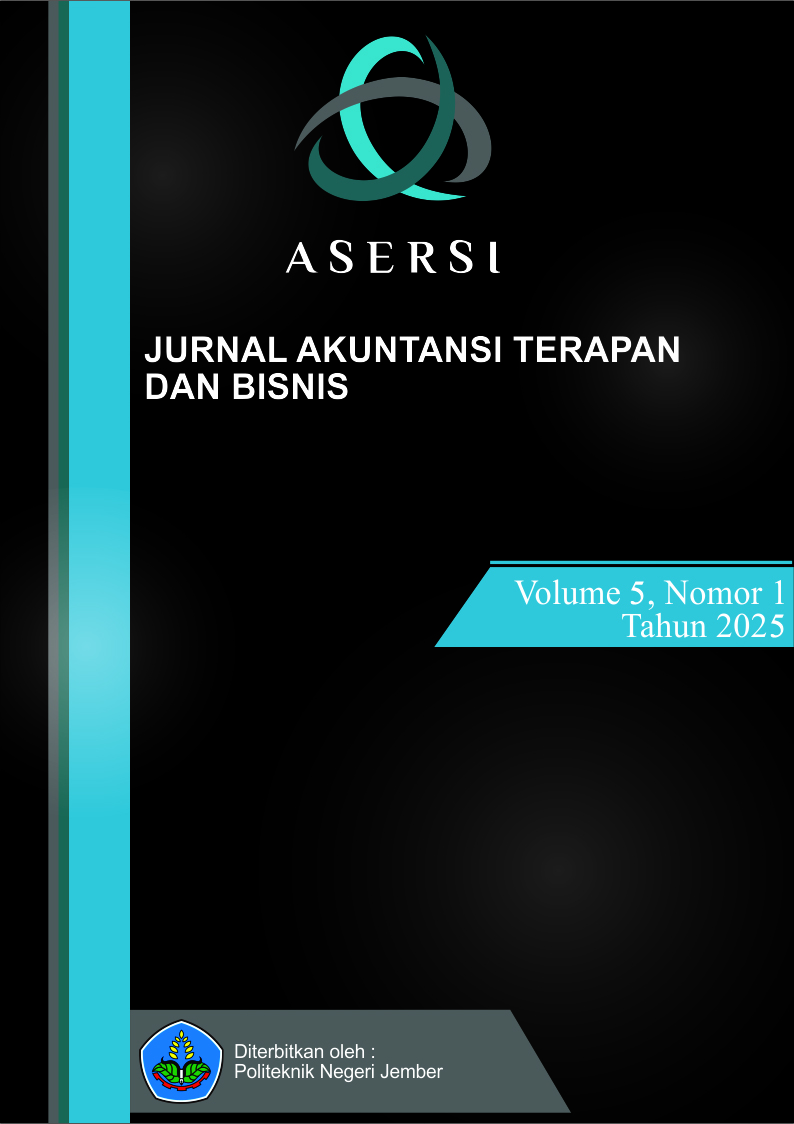Pengaruh Penerapan E-Samsat terhadap Kepatuhan Wajib Pajak Kendaraan Bermotor Dimoderasi oleh Sosialisasi Perpajakan
DOI:
https://doi.org/10.25047/asersi.v5i1.6171Keywords:
E-Samsat, Taxpayer Compliance, Motor Vehicle Tax, Tax SocializationAbstract
Motor vehicle taxpayer compliance is a key factor influencing provincial-level regional tax revenue. This revenue is crucial for funding local development. However, high levels of outstanding motor vehicle tax payments in many regions, including Subang, indicate low taxpayer compliance. This study examines the effect of implementing E, Samsat, on motor vehicle taxpayer compliance, moderated by tax socialization efforts at the Subang District SAMSAT office. A quantitative research design was employed, using random sampling to select respondents from the population of motor vehicle taxpayers registered at the Subang SAMSAT office. A sample of 100 respondents was determined using the Slovin formula, and data were collected via questionnaires. Partial Least Squares Structural Equation Modeling (PLS,‑SEM) analysis was conducted using SmartPLS version 4.1.1.2. The findings indicate that the implementation of E, Samsat, has a positive effect on motor vehicle taxpayer compliance. However, tax socialization does not moderate this effect. These results suggest that, while E, Samsat, implementation has improved taxpayer compliance in Subang, existing tax socialization efforts have not yet strengthened this effect.
Downloads
References
Alghaviqi, M. W. A. (2023). Pengaruh Penerapan Sistem Informasi E-Samsat Terhadap Tingkat Kepatuhan Wajib Pajak Kendaraan Bermotor (Studi Kasus Pada Kantor Samsat Kabupaten Garut). Jurnal Riset Akuntansi, 15(2).
Efendi, R., & Taufik, I. (2024, June 13). Kantor P3DW Samsat Subang Genjot Pendapatan Pajak Kendaraan. Www.Rri.Co.Id. https://www.rri.co.id/keuangan/752848/kantor-p3dw-samsat-subang-genjot-pendapatan-pajak-kendaraan
Ghozali, I. (2021). Partial Least Squares Konsep, Teknik dan Aplikasi Menggunakan Program SmartPLS 3.2.9 untuk Penelitian Empiris (3rd ed.). Badan Penerbit Universitas Diponegoro.
Haryanto, D. A., & Lingga, I. S. (2024). Pengaruh Penerapan E-Samsat Dan Sanksi Perpajakan Terhadap Kepatuhan Wajib Pajak Kendaraan Bermotor. Jurnal Riset Akuntansi Politala, 7(1), 28–39. http://jra.politala.ac.id/index.php/JRA/index
Herawati, L. N., & Hidayat, V. S. (2022). Pengaruh Penerapan E-Samsat Dan Sanksi Perpajakan Terhadap Kepatuhan Wajib Pajak Kendaraan Bermotor (Studi Kasus Pada Wajib Pajak Di Samsat Kota Cimahi). Jurnal Penelitian Akuntansi (JPAK), 10(1), 2722–7502.
Peraturan Pemerintah Republik Indonesia Nomor 35 Tahun 2023 Tentang Ketentuan Umum Pajak Daerah Dan Retribusi Daerah (2023).
Sugiyono. (2024). Metode Penelitian Kuantitatif (Setiyawami, Ed.; 4th ed.). Alfabeta.
Wardani, D. K., & Juliansya, F. (2018). Pengaruh Program E-Samsat Terhadap Kepatuhan Wajib Pajak Kendaraan Bermotor dengan Kepuasan Kualitas Pelayanan Sebagai Variabel Intervening (Studi Kasus Samsat Daerah Istimewa Yogyakarta). Jurnal Akuntansi & Manajemen Akmenika, 15(2). https://www.kemenkeu.go.id/apbn2016
Downloads
Published
How to Cite
Issue
Section
License
Copyright (c) 2025 Kiki Rizki Apriliani, Arry Irawan

This work is licensed under a Creative Commons Attribution-ShareAlike 4.0 International License.
You are free to:
- Share — copy and redistribute the material in any medium or format.
- Adapt — remix, transform, and build upon the material for any purpose, even commercially.
Under the following terms:
- Attribution — You must give appropriate credit, provide a link to the license, and indicate if changes were made. You may do so in any reasonable manner, but not in any way that suggests the licensor endorses you or your use.
- ShareAlike — If you remix, transform, or build upon the material, you must distribute your contributions under the same license as the original.
- No additional restrictions — You may not apply legal terms or technological measures that legally restrict others from doing anything the license permits.




